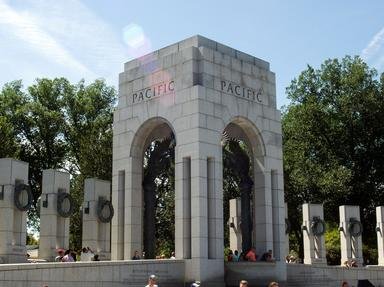Quiz Answer Key and Fun Facts
1. The Solomon Islands became the focus of attention of allied planners in late June 1942. Why?
2. On August 7 1942 units of the 1st Marine division led by General Vandergrift landed on Gaudalcanal and nearby Tulagi Is. completely surprising the Japanese defenders. The still incomplete airfield was quickly secured and later renamed ________________ field.
3. On the evening of August 8th Vice Admiral Frank Jack Fletcher commanding Task Force 61 which was covering the landings was forced to withdraw his three carriers _____________, _____________, and _______ because land based enemy planes had inflicted heavy losses on his aircraft and he could not risk his precious flat tops.
4. On the night of August 8 Vice Admiral Gunichi Mikawa led a force of seven cruisers and a destroyer into the channel between Guadalcanal and Savo Is. and inflicted a stunning defeat on the Allied cruiser force screening the landings.
5. The victims of the Battle of Savo Island were the first of dozens to litter the seabed between Savo Island, Tulagi and Guadalcanal. The area was soon dubbed ___________ ___________.
6. The looming silhouette of _________ Island formed the backdrop to all the major surface actions fought in the waters north of Guadalcanal.
7. The Japanese high command was determined to dislodge the Marines' foothold on Guadalcanal and troops were despatched to do this. They were landed and supplied in nightly runs by destroyers and transports led by Admiral Raizo Tanaka in an operation which soon became known as the '____________ ____________'.
8. As Japanese reinforcements approached Guadalcanal from their bases at Rabaul and New Ireland they had to run the gauntlet known as 'The __________' a narrow stretch of water between two parallel island chains.
9. Time and again throughout the six month campaign General Vandegrift and his Marines received early warning of the approach of Japanese air strikes and seaborne reinforcements by a dedicated group of observers known as ____________.
10. Admiral Yamamoto, still smarting from the defeat at Midway, was determined to engage the American carrier force and inflict a defeat, saw an opportunity on August 23 when the Combined Fleet sallied from Truk lagoon to provide distant cover for one of Admiral Tanaka's supply runs. The resulting two day carrier action established the reputation of the _____________ as a lucky ship.
11. On September 15 the __________ became the third major US carrier to be lost in the Pacific theatre in 1942 when she was sunk by an enemy submarine south east of San Cristobal Island.
12. Lookouts on the cruiser Helena reported "Ships visible to the naked eye" to which an exasperated radar operator exclaimed "What are we going to do, board them!" This was the tense situation on the night of October 11 which preceded the clash which became known as the ______ __ ____ ________.
13. The Marines at Henderson Field suffered the worst bombardment of the campaign on the night of October 13-14 when the battleships ____________ and ________ subjected them to several hours of sustained 14 inch shell fire.
14. On October 26 the carrier fleets of both sides again clashed in the 'Battle of _______ __________'.
15. The struggle for supremacy in the waters around Guadalcanal reached a climax in mid November as both sides shaped up for a knockout punch. According to one US commander the action on the night of November 12-13 resembled the 'Gunfight at OK Corral'.
16. During the night action of November 12-13 two American Admirals perished. Who were they?
17. A tragic aftermath to this night action took place the next morning when the badly damaged cruiser Juneau was torpedoed and sunk by a submarine taking with her the five _______________ brothers.
18. When Admiral Halsey heard of the deaths of Admirals Callaghan and Scott in the terrible events of the night before, he realised he had nothing to counter the next Japanese move except his two big battlewagons which were acting as escorts to his last operational carrier, Enterprise. Without hesitation he dispatched the battleships _____________ and __________ ___________ the following night to the waters around Guadalcanal to protect Henderson Field from the Japanese Navy.
19. On the night of November 30 a remarkable action took place when destroyers of Admiral Tanaka's Tokyo Express devastated an American cruiser force with their _______ _________ torpedoes.
20. On January 29-30 1943 the last major naval battle of the Guadalcanal took place and resulted in the loss of the heavy cruiser USS ____________.
Source: Author
mstanaway
This quiz was reviewed by FunTrivia editor
bloomsby before going online.
Any errors found in FunTrivia content are routinely corrected through our feedback system.

